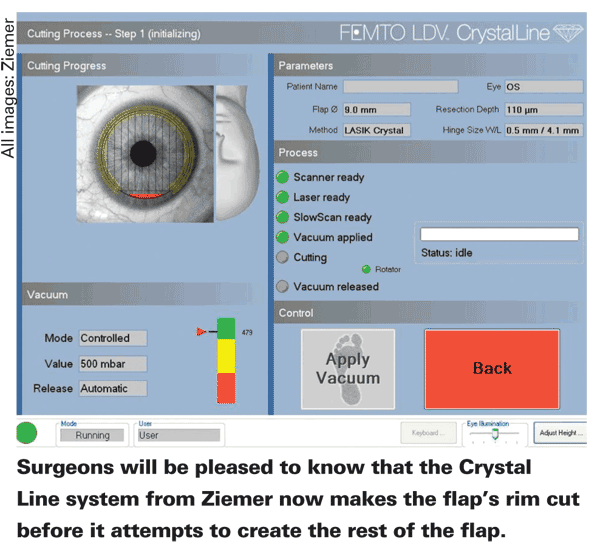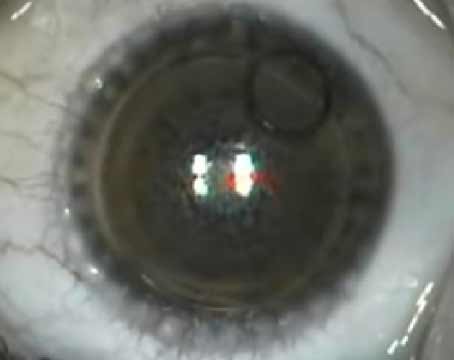In an effort to respond to some criticisms made by surgeons familiar with Ziemer's Femto LDV femtosecond laser, the company is rolling out an upgraded system, the Crystal Line. The Crystal Line upgrade is also available for existing Femto LDV systems. Here's a look at what prompted the upgrade, what's changed with the Crystal Line, and what's remained the same.
A New Rim Cut
The Crystal Line changes the way the laser creates the rim cut on the flap, moving away from cutting the entire flap in one fell swoop and toward cutting the rim as a separate step. "This is a major change that users will notice is different from how the device cut flaps before," says Tony Wirthlin, PhD, Ziemer's vice president of marketing. "The Crystal Line cuts the edge of the flap first, and by doing that obtains a well-defined edge. Before, surgeons would sometimes have an edge that wasn't clearly defined."

Overland Park
Sometimes, if the applanation wasn't all the way out to the periphery of the cornea, you wouldn't get a clean edge. There would be tissue bridges there that you'd have to break manually before you could lift the flap. So, Ziemer redesigned the laser's software and the way the laser moves during the treatment and now it works well in this regard. It now goes around the rim first, cutting it before it cuts the middle area of the flap. The flaps lift very easily now." Previously, the laser would just cut across the applanation plane with one cut, similar to a microkeratome. "Now we get a better-defined edge with the ring cut," says Dr. Wirthlin. "We're seeing that flaps are easier to open and the edges are smoother. It also allows some of the gas that's generated during the process to escape through the edge while we're cutting inside of the stromal area. That means you get a very transparent flap and very little gas, and can immediately apply the excimer after you've opened the flap."
Increased Speed
The Crystal Line also has a pulse rate of just over 5 MHz, or 5 million pulses per second, which is the fastest in the femtosecond field. "With a very high pulse rate, you can work with very low pulse energy," says Dr. Wirthlin. "With the high rate, you can deploy many more pulses when making the cut, which takes no more than 20 seconds. Even though the optics allow the spots to be very small, we get a complete dissection of the stroma without interstitial spaces between the spots. The system actually overlaps the spots quite heavily." The procedure time, which includes placing the handpiece on the patient's eye, creating the flap and then removing the handpiece is on the order of 30 seconds. Dr. Wirthlin says the total procedure time, which many refractive patients are most concerned with, and which usually extends from when the patient lies down to the time he can get up off the table with both eyes corrected, is around five to six minutes.
Dr. Wirthlin says the crystal-tuned optics also make for a more controlled spot size in all planes, to help avoid complications. "The typical femtosecond laser can achieve a reasonably small spot size in the x/y plane, but often the focus in the vertical dimension, the z plane, isn't as good," he explains. "This results in a more cigar-shaped spot, which could cause damage to Bowman's membrane if you were to get too close to it, or cause gas breakthrough through Bowman's. By focusing tightly, you can avoid that problem, even while cutting close to Bowman's. This allows procedures such as sub-Bowman's keratomileusis that use flaps thinner than 100 microns. The Crystal Line's wavefront has been optimized so all the energy hits the same plane."
A Family Resemblance
The Crystal Line is nearly identical in its physical layout to the original Femto LDV. Still present are the compact body and wheels that allow it to be moved from room to room at a practice or even from one surgicenter to another. It also uses the same articulated arm that allows the surgeon to swing the laser head in and out of the operative field. The depth of the flap cut is also still determined by the use of plastic spacers with certain defined thicknesses called intershields. The intershield spacers allow the creation of flaps with thicknesses of 90, 100, 110 or 140 µm. The reproducibility of flap thickness is a little better than ±5 percent.
Like the Femto LDV, the Crystal Line can also perform corneal cuts other than LASIK flaps. "It can create pockets for presbyopic inlays, circular tunnel incisions for intrastromal ring segments and perform lamellar keratoplasty with a separate laser handpiece that allows deeper cuts of up to 500 microns," explains Dr. Wirthlin. Each of the different functions requires users to purchase a separate license; and the license fee for the lamellar surgery program is included with the purchase of the lamellar surgery handpiece. Dr. Wirthlin can't cite specific license fees because, he says, "They're usually part of the overall system price, since a doctor will specify what he wants to do with the system when he purchases it."
In terms of getting the Crystal Line upgrade for an existing Ziemer Femto LDV, Dr. Wirthlin says the particular upgrade path differs depending on how old the Ziemer laser is that needs to be upgraded. "For lasers installed in 2010, it's a very straightforward upgrade," he says. "Even those installed in 2009 can usually be upgraded in the field. All of the lasers installed prior to 2009 may need to come back to the factory, but that's determined on an individual basis." He says the price for an upgrade to a 2010 machine would be "minimal," but that it would be relatively more expensive for older devices. Each customer receives a price quote after Ziemer has had a chance to evaluate his system.
"It's important to understand that the Crystal Line isn't something that's been brought completely new from the drawing board," says Dr. Wirthlin. "Instead, it's more of the culmination of a succession of small improvements that we've made to several of the laser's components over time."




